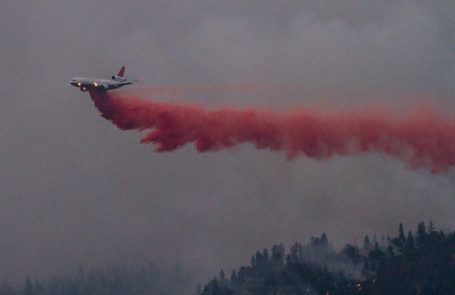Wary of bankruptcy, PG&E seeks protection from wildfire costs
by Chris Reed | June 25, 2018 10:22 am

California’s three large investor-owned utilities are renewing efforts to allow them to make ratepayers cover the costs of wildfires that authorities blame on utilities’ mistakes or poor maintenance.
Pacific Gas & Electric officials made this clear last week when they announced they expected to have at least $2.5 billion[1] in liabilities from the wildfires that scarred the wine country of Northern California last October. That sum is only for 12 relatively small blazes that the state blames on PG&E’s failure to maintain equipment and clear brush near power lines. Authorities are still looking at what caused the biggest blaze – the Tubbs fire – which torched more than 3,000 homes in Sonoma County and is blamed in the deaths of 22 people.
PG&E CEO-President Geisha Williams used a conference call with analysts to make the case[2] for state legislation to protect electricity utilities from bankruptcy in an era in which huge wildfires – blamed on hotter, drier weather – are more common than ever. PG&E only has an estimated $840 million in insurance coverage to deal with the 200 and counting lawsuits from the wine country conflagrations.
Williams said “flawed” state laws made utilities responsible for fire risks that were beyond their control. But in a decision-making process that began last summer – before the wine country blazes – and ended after they were finally put out, the California Public Utilities Commission rejected a similar argument put forward by San Diego Gas & Electric. In August, CPUC staff recommended that commissioners reject an SDG&E request to pass along to ratepayers $379 million in unrecovered costs from 2007 wildfires that ravaged San Diego County. After three months of wavering, the CPUC board voted unanimously in late November to deny[3] the request.
Williams said negative media coverage of the October fires complicated utilities’ efforts to get help from the California Legislature. But some utility watchdogs are still wary of state lawmakers, whom they see as sending out mixed signals on wildfire liabilities.
On the one hand, the state Senate voted 39-0 in May and an Assembly committee voted 15-0[4] last week for Senate Bill 819[5]. It would ban the CPUC from allowing utilities to pass along to ratepayers the costs of fines or penalties as well as the cost of damages that were “caused” by a utility’s infrastructure. Only costs the CPUC deems “just and reasonable” can be shifted from shareholders to ratepayers under the legislation. PG&E and Southern California Edison expressed “concerns” about the bill without formally opposing it, according to a legislative analysis[6].
Benign bill pushing responsibility – or stealth bailout?
But another bill that had similarly lopsided support in the Senate is drawing a very mixed response. Senate Bill 1088 passed the Senate 34-2 in late May and survived an Assembly committee vote[7] last week with eight lawmakers in support, two in opposition and five declining to vote.
It would require utilities “to submit a safety, reliability and resiliency plan to the California Public Utilities Commission every two years.” It would also require the state Office of Emergency Services “to adopt standards for reducing risks from a major event and requires the office to update the standards at least once every two years.”
Supporters – including PG&E, SDG&E, labor unions and some counties hit hard by last year’s blazes – depict the measure as a benign attempt to make sure utilities are prepared to handle their responsibilities.
But critics see the language requiring the state to regularly “update” how it evaluates risks posed by the biggest blazes as potentially giving legal ammunition to the utilities – specifically, to their arguments that emerging, more dangerous conditions should change what costs can be shifted on a “fair and reasonable” basis to ratepayers.
Formal opponents of SB1088 include groups which have standing to challenge utilities’ proposed rate hikes (The Utility Reform Network and the Office of Ratepayer Advocates); business interests (the California Manufacturers and Technology Association, the Western States Petroleum Association and farm groups); and green activists (most notably the California Environmental Justice Alliance).
- $2.5 billion: https://www.elp.com/articles/2018/06/pg-e-taking-2-5b-charge-on-2017-wildfires-more-to-come.html
- make the case: https://www.bizjournals.com/sanfrancisco/news/2018/06/22/pcg-ceo-wildfires-bankruptcy.html
- deny: http://www.sandiegouniontribune.com/business/energy-green/sd-fi-sdge-wildfirecaseruling-20171130-story.html
- voted 15-0: https://leginfo.legislature.ca.gov/faces/billVotesClient.xhtml?bill_id=201720180SB819
- Senate Bill 819:
- analysis: https://leginfo.legislature.ca.gov/faces/billAnalysisClient.xhtml?bill_id=201720180SB819
- vote: https://leginfo.legislature.ca.gov/faces/billVotesClient.xhtml?bill_id=201720180SB1088
Source URL: https://calwatchdog.com/2018/06/25/wary-of-bankruptcy-pge-seeks-protection-from-wildfire-costs/